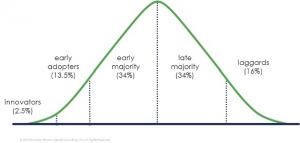
Help your company find its voice on social change.
Recently, Georgia legislators put new restrictions on voting. On Friday, Major League Baseball pulled the All-Star game from Atlanta and moved it to Denver. Two of Georgia’s corporate giants, Coca-Cola and Delta, finally broke their silence and made statements opposing the new laws.
And it’s not just Georgia companies who have decisions to make. Lawmakers in more than 40 states have plans for new restrictive voting laws. Rich Lesser, the chief executive of Boston Consulting Group, says, “…business leaders are still facing challenges on how to navigate a range of issues, and the elections issue is among the most sensitive.”
You might say companies are doing some fast math to predict the best way to respond to recent events, or that they’re searching the corporate conscience. We think they’re firming up their place on the curve.
What Curve?
In the early 1960’s, Professor Everett Rogers developed the Diffusion of Innovations Curve to describe consumers who adopt new products. We use the curve to identify and enlist people within our client organizations who will mobilize others for a change initiative. 
The same curve can be applied to any kind of new thinking or behavior. Let’s break it down.
- 2.5% of people are all-in, no matter what you introduce. They are the Innovators. They often come up with the ideas in the first place.
- 13.5% are keen to adopt change. They are the Early Adopters. They make it safe for others to buy in.
- 34% are generally positively predisposed to change. They’re the Early Majority. Once they see the change is safe, they’re in.
- 34% are generally resistant to change. They are the Late Majority. When they see others adopting, they will start thinking about it and eventually come around.
- 16% will never willingly buy in. They are the Laggards.
We lump together the left side of the curve. Innovators build the band wagon and Early Adopters jump on. They create momentum that brings the rest along.
Let’s stipulate that certain social changes are not going away. That, however long it takes, those forces will someday represent the majority opinion. As it relates to these movements, like protecting voting access, it’s worthwhile for organizations to find a home on the curve.
Start by answering a few questions.
Who are you?
What is your brand? What is your company culture? When you think about those questions, do words like “innovative,” “adventurous,” and “fresh” come to mind? Or are you hearing “traditional,” “safe,” and “reliable” in your head?
Think about your organization and place it on the curve. Consider your placement when you make decisions relative to powerful national currents.
Nike is a company that knows exactly who they are and where they land on the curve. When they launched an ad campaign featuring Colin Kaepernick, the former NFL quarterback who knelt during the anthem to protest police brutality, there was a backlash. But the boycott and the social media sneaker burning were utterly inconsequential; Nike’s value quickly increased by $6 billion and sales jumped 31%. Said Nike founder Phil Knight, “You can’t try and go down the middle of the road. You have to take a stand on something.” Spoken like someone who lives on the left end of the curve.
Who is your customer?
Are you serving the masses? Is your market more specialized? Is it age-based? Regional? Does your product or service serve a faith-based customer, or a particular ethnic community? You certainly feel you know your customer. Try to place them on our curve.
Companies like Coca-Cola and Delta are definitely selling nationally (if not globally). They want a lot of people to love them, but they are most solicitous of the 18-49 demographic. Donny Deutsch, the marketing guru, points out that big companies generally don’t care about him, because he’s in his 60s. But he calls being on the “right side” of social issues the “price of entry” for a millennial customer.
Doubling down on the demographic pressure, black business leaders coalesced in response to the Georgia laws; they made their position known and urged others to join them. On the Wednesday following passage of the Georgia bill, Delta CEO Ed Bastian released a “crystal clear” memo opposing the bill, stating for good measure, “The entire rationale for this bill was based on a lie.” A like-minded statement from Coca-Cola CEO James Quincey soon followed.
These companies have decided who their customers are and what they want to hear. Did that perception nudge these companies from early majority to early adopter? Maybe, but they have chosen a spot for now.
What will you do?
Or not do? It seems that organizations like Nike, the MLB, Coca-Cola, and Delta determined that silence was not an option. And, true to the curve, they are making the way safe for other companies. Over 100 organizations have made similar statements in the wake of the news from Delta and Coke.
No matter who you are, who your customer is, or what change is sweeping the nation, it’s smart to know where you stand, on the curve.




